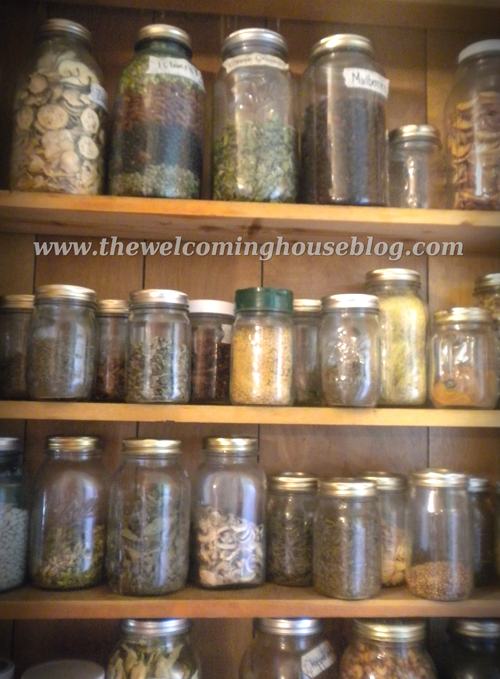Today I have a treat for you.
I have a guest writer, Heather, from The Welcoming House Blog here today to tell you about how she has prepared her pantry.
She is prepared for a food crisis, are you?
I'm not, but I plan to be, very soon.
Good morning to you!
As a blogger who covers Food Storage every single week on Food Storage Saturdays, I can tell you that over and over I hear the same three questions or comments in regards to food storage. When Val asked me to guest post for her, I was thrilled simply because this is a subject I love to write on. I love to show people how common sense it is to start and use a food storage system, and how to do it easily and frugally.
Food storage, as it is now called, used to be called "saving for a rainy day", "keeping a pantry" or, as my mother colorfully called it "Puttin' up for the winter". We have become so used to having a grocery store on every corner that we forget that sometimes, having that food storage is the best insurance you can ever pay into!
For those of you just starting, I have a couple common suggestions for you that it seems like everyone asks, and would encourage you to ask any other questions in the comments. There is a lot of wonderful information easily available out on the Web, and both Val and I would love to help you in any way we can.
My first suggestion when it comes to food storage is:
Store what you eat, and don't jump on the sales bandwagon unless you can use it.
If you are a frugal bargain shopper like I am, sometimes your sales shopping can get a little out of hand. Now, when that is something like clothing or shoes, most of those purchases can be passed on to another person in your family. But with food, it is a whole different ball game. You do not want to be wasting your money on food you will never eat and never share with someone else, all because it is on sale. Not only do you use up valuable space for that box or can, consider it like this: Would you walk over to your trash can and throw a $1 or $5 bill into it? No you would not, and neither would I. So do not, ever, purchase food on sale that you have not tried before and would have no idea how to use in meals.
My best suggestion in answering this question is to tell you that when you go grocery shopping for a normal week, try to buy two of everything you are getting that is shelf stable. Sit down with your family and intentionally try to plan a couple meals that week that everyone likes, and that can be made from mostly, or all, shelf stable ingredients. Then take a highlighter and when you make out your grocery list, highlight those ingredients. Seeing that bright marker on your list may keep you from buying something on impulse because you know that you need to allocate funds for your extras that are going to start building up your pantry.
If you are having trouble setting enough money aside to add to your grocery budget, consider choosing cheaper meals for one week, or letting go of something extra, so that you can get some extra food on your shelves for a time when you will most certainly need it. I have also shared with many people that how we got started was by taking every single piece of change that we could find anywhere for a month and adding it into a jar. At the end of the month we were astonished at how much we had, and spent it on food for the pantry.
And that really leads into my next Important thing to remember:
Anyone, living anywhere, can have a food pantry.
Three minutes of searching for creative food storage ideas on Google or Pinterest will lead you to really start rethinking how you do things. One of the biggest excuses that I hear often about beginning a food pantry is that folks have no idea how to store it. I often try not to giggle a little bit, because I have seen some brilliant solutions to that excuse, and some seriously funny ones, such as turning cases of green beans into a coffee table covered with a blanket. Really, you simply need to rethink the space you have. You do not have to have an entire basement dedicated to food storage. Or a closet. Think about small spaces—a single cupboard? Under a bed? An unused cabinet or drawer in a bedroom. Food storage can be disguised a number of ways, and we are, as a rule, creative as humans. If you do not count yourself in the creative category, I would suggest you sign up for Pinterest. Maybe two visits and you will have more ideas that you know what to do with. In all seriousness though, think about your space and how best to use it, and then get started. Before you know it, you will be finding a way to better use your space and rearrange it for more of that food security.
Last, but certainly not least, on the list of Important things to remember is this:
Start with the basics, and add the extras as they come on sale.
What are the very basics that most people need? Well certainly, as we look at the disaster unfolding in West Virginia, water should be on the top of your list. Set aside one gallon of water for every single person in your family, and don't wait to get it until the "next time around". If you could read the heartbreaking emails that come in to me every day right now about what those poor folks are going through, you would not hesitate for a second.
After water comes the basic food groups—-and what your family eats. When starting with building a food storage, many people have no idea where to start. Consider the building blocks of most meals and what you eat. Grains, Vegetables, Fruit, proteins are the starters. If you do not have a wheat grinder, then purchase flour and store it (remember to freeze it first to kill off any nasties that might be lurking in there) and cover your grains. Another option for grains is choosing rice, which, by the way, stores very well in a 2 liter soda bottles that have been washed and dried. Vegetables and Fruit can be purchased in cans or cases, and stored in their original packaging, and are good for quite a while. Meat also comes canned, or you can can your own, depending on how handy you are.
But more than anything, just because chocolate chips are on sale and you can get 10 bags of them for half of what you normally would, please, resist the temptation until you have all your basic bases covered. As awesome, and wonderful, and tempting as those bags of chocolate chips, or cake mixes, or rice a ronis or whatever are on sale for, think about one thing: Would you be willing to eat that every single day for a week straight because you ran out of the things that you really needed, all so you could get a good deal? Now my kids love chocolate chips, and would be thrilled, but the worst part about that bad decision is that it would absolutely impact their health if we did it for more than a day or two. Once you have those basics covered, by all means, jump right in there and get those chips. Because sweet treats make food storage just a little easier to handle on the bad days.
I hope that this has helped you! I want to thank Val for her sweet offer to allow me to guest post, and I want to encourage YOU to step forward and start doing something new, right now, for you and for your family. Rely on the stores a little bit less this year, and build up a pantry for your family and loved ones. Many many wonderful people are struggling through tough times, and I am always thankful to get those sweet emails thanking me for helping encourage them to do something like food storage that they ended up living on when someone lost a job or got terribly ill.
May your day be a bright and beautiful one.
Blessings to you and yours,
~Heather, author of The Welcoming House Blog
Thanks, Heather! This is good information and a great starting point for us all.
Here are links to my Survival in a Crisis series:
Let me know what you have done or are planning to do.




Val, I did clean out my pantry here while back. Ended up having a grocery bag full of stuff that was outdated. Obviously, I need to menu plan better and bring cans to the front from time to time. Thanks for the articles on preparedness, I'm enjoying them.